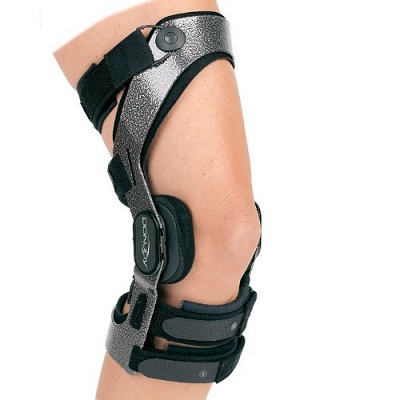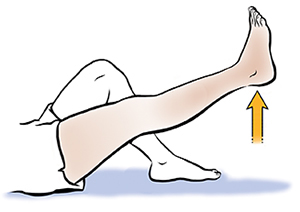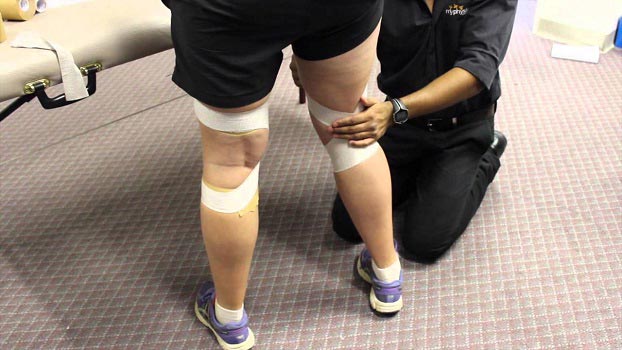Hyperextended Knee can cause anyone but very common in athletes, notably those who play sports like football, skiing, soccer, or lacrosse. The hyperextended knee also has known as hyperextension knee or “genu recurvatum” takes place when the leg excessively straightens at the knee joint, putting stress on the knee structures chiefly on the back of the knee joint.
The severity of the condition is based on the cause of injury and each athlete’s body. In most instances, hyperextension of the knee will have noticeable symptoms comprising swelling, sharp localized pain, reduced range of motion, and instability on the affected leg. Treatment of hyperextended knee comprising- RICE Protocol, exercises, physical therapy, hyperextended knee brace and in severe cases require surgery.


According to the American Journal of Sports Medicine, female athletes have increased joint instability, turning them at a higher risk of knee injury than men, chiefly those who take part in high-risk sports. It’s usually the result of a direct blow to the knee or forces spawned during a quick deceleration or stop. In these occurrences, a large amount of stress is put upon one or more major ligaments of the knee such as medial collateral ligament (MCL), lateral collateral ligament (LCL), anterior cruciate ligament (ACL), posterior cruciate ligament (PCL) or popliteal ligament (the ligament along the back of the knee) may be strained or ruptured.
Hyperextension Knee Symptoms
Symptoms of the hyperextended knee can include swelling, severe knee pain, and visible bruising. A hyperextended knee is usually easy to identify when it happens. An individual usually feels the knee bend backward out of line with the leg. As hyperextension of the knee can develop to varying degrees of severity, the manifestations of the injury based upon the individual athlete’s body and the overall strength of the knee joint. Typical symptoms of knee hyperextension comprise:
Instability of the Knee- Following a hyperextension injury, you may notice instability in your knee joint. Many individuals address feelings of their leg “giving out” while stepping or having trouble standing on one leg.
Pain- A localized pain is expected following hyperextension of the knee joint. Pain can vary from mild to severe and typically increases when ligaments or other structures are damaged or torn. Pain is specified as a mild to a sharp pain in the back of the knee or pinching pain in front of the knee joint.
Decreased Mobility- You may have trouble flexing or straightening your leg after a hyperextension injury. This could be because of swelling around the knee, which can inhibit your knee’s movement and damage to the internal structures such as the ACL, PCL, popliteal ligament, or meniscus. This will reveal a shortened range of motion because of weakness in the joints, swelling, and pain.
Swelling and Bruising- Following an injury, you may recognize immediate or delayed swelling and bruise of the knee and surrounding area. Fluid accumulation within the knee joint is typical after hyperextension of the knee. This can be mild or more severe, and it’s your body’s way of responding to the injured tissues.
If the hyperextension of the knee is traumatic enough to cause harm to ligaments, cartilage, or other soft tissues, bruising may develop on the skin. Knee hyperextension can lead to a severe or minor injury, individuals experiencing these symptoms may benefit from seeking medical attention.
Knee Hyperextension Causes
Hyperextension typically occurs when the knee absorbs strong, sudden force while they straightening the leg. When an excessive amount of force the knee into extension, causing soft tissue damage, swelling, and potentially tears or strains of the ACL, MCL, LCL, or PCL. Common causes of knee hyperextension include:
- Pushing the femur or patella over the tibia and placing excess stress upon one or more of the main ligaments within the joint. An athlete stopping unexpectedly and placing all of their weight might experience this type of impact on one leg to try and do so.
- Unexpected force to the front of the knee, causing the backward movement of the knee, may cause the ACL to strain or tear. This impact would occur in traumatic physical situations, like a footballer being tackled by the legs or a player being slid into.
The method by which it causes a knee hyperextension can predict the severity of the condition. In minor cases, an athlete will notice small amounts of pain or swelling. In traumatic injury, however, hyperextension of the knee can also cause damage to the encompassing ligaments, cartilage, and soft tissues.
Other Causes Include:
- Laxity of the knee ligaments
- Instability of the knee because of ligaments and joint capsule injuries
- Irregular alignment of the femur and tibia
- The discrepancy in lower limb length
- Certain diseases such as cerebral palsy, multiple sclerosis, muscular dystrophy
- Congenital defect
Diagnosing Knee Hyperextension
The history will offer clues to the diagnosis as a prior knee injury. A physical examination will help confirm and grade the injury, including joint mobility, visible injury, bruising or swelling, torn ligaments, and locking of the joint. Diagnosing knee hyperextension will vary from patient to patient because the severity of the injury is broad. Others who suffered a minor hyperextension may have mild swelling and slightly reduced mobility.
Imaging is required in severe injury and particularly if surgery is contemplated. MRI and X-ray imaging are typically performed. Athletes seeking medical attention for a potentially hyperextended knee will likely have different experiences based on the severity of their injury. Most diagnostic processes will involve the following factors:
Patient History
A physician will consider the medical history of an athlete before advising treatment. For instance, an athlete with prior knee injuries is also more vulnerable to a more severe injury.
Physical Examination
The physical examination will aid the physician in determining the severity of the injury and if further imaging is required. During a physical examination, your physician will check the athlete’s range of motion by moving the leg forward and backward. In some patients, the leg is locked indicating a more severe injury. Throughout this process, the doctor also will check for visible bruising or swelling which will result in a torn ligament or other internal damage.
Imaging
Typically, imaging is performed if the injury is severe enough. Typically an MRI and/or x-rays are performed. In some cases, imaging won’t be used for a doctor to diagnose an athlete with a hyperextended knee. If, however, surgical intervention is anticipated to be used as a treatment, imaging is necessary to develop plans for the procedure and recovery.
Hyperextension Knee Treatment
The first approach of knee hyperextension is like other soft tissue injuries, it is advisable to follow the RICE protocol–
Rest- Stop the activity that causes injury and seek medical attention. Take a break from any activities. A gentle isometric exercise is best at this time. Anti-inflammatory medications can help decrease swelling and pain.
Ice- Apply Ice the affected knee for 20 minutes 5 times per day. Ice can reduce swelling and manage pain. Always put a piece of towel between the ice and your skin to inhibit skin irritation.
Compression- Compression of the knee with a compression wrap can help reduce swell and pain.
Elevation- Try to elevate your leg above your heart level. When you lie on the bed, place your leg on a pillow.
The treatment of a hyper-extended knee will vastly depend on the severity. Precisely, the treatment chosen by a physician will upon the strength of the athlete’s knee joint, medical history, and their devotion to return to an athletic event. Further, the important factor of the hyperextension knee injury severity (such as ligament or cartilage damage) will also influence the treatment process.
In traumatic cases, surgery may be significant to recover the damage that took place during the hyperextension of the knee. It will aim this process at repairing and reconstructing ligaments and meniscus. If surgery is mandatory, physical therapy will guide restore strength and range of motion to the athlete’s knee joint. Even though the treatment of a knee hyperextension will differ, surgery will only be significant for the more severe precedents of the condition.
Surgery for Knee Hyperextension
Surgery for hyperextension of the knee may be unavoidable when an athlete has damaged one of the major knee ligaments. A common example is an anterior cruciate ligament or ACL injury. Fortunately, over 80 percent of athletes whose hyperextension causes this injury return to athletic activity? For individuals requiring surgery, common procedures include:
Arthroscopic surgery involves inserting a small, remotely controlled endoscopic camera into an incision to provide a physician with a clearer view of an affected area. Some knee damage can be corrected through this process. It may perform reconstructive surgery upon damaged tissue resulting from knee hyperextension. An ACL reconstruction is the prevalent form of this surgery. The essence of this surgery will depend upon the specific injury and level of athletic sport that took part in by the athlete.
If surgery becomes significant, recovery will vary on a case through case basis. Immobilizing the joint, a shortened workload, physical therapy, and rehabilitation plans.
Exercises for Hyperextension Knee
Knee strengthening exercises are planned to return your knee to its original level of strength and stability. After having a hyperextended knee injury, it is necessary to rest the knee for several weeks, using RICE protocol such as cold compresses to diminish the swelling in the knee. As a result, strengthening exercises must be implemented after the injury has restored in order to strengthen the stability of the knee. Consulting a physician about your hyperextended knee will serve you to get an accurate diagnosis and determine if surgery is necessary.
Straight Leg Raise (SLR)

Straight Leg Raise (SLR) exercise strengthens your knee by strengthening the quads that support the knee. By performing SLR, Lie down on the ground and lift your hyperextended leg straight and your other leg bent at a 30-degree angle from the knee. Then you will tighten your abdominal muscles and lift your injured leg slowly from the ground, making certain not to raise it larger than a 45-degree angle. Hold the position for 5-6 seconds then come back to the original position and take a few seconds rests. Do the exercise 8 to 10 repetitions.
Quarter Squats

We plan knee squats to enhance the range of motion in your knee and strengthen the muscles that hold your knee joint. The quarter squat helps increase the strength of the quads, glutes, and hamstrings. Crouch down by moving your hips back and flexing your knees. Continue until your knees make a 45-degree angle to the floor. Do the exercise 8 to 10 repetitions.
Hamstring Strengthening Exercise

We design this exercise to strengthen your hamstrings and enhance your injured knees range of motion. For doing this exercise, firstly you will lie down on your stomach with full leg extended. Then bend your hyperextended knee until you have pain in the knee area. Maintain this position for five (5) seconds and slowly return your leg to its original position. And you will fully stretch in your hyperextended knee; feel tightness in your hamstrings as you do this exercise.
Hyperextended Knee Tape

Knee taping is designed to provide pain relief and support and protect the knee joint from harm when you move around. Support your knee after a mild hyperextension injury with a simple taping technique.
Does a Knee Brace Help Hyperextend Knee?
Knee brace supports will help you with the hyperextended knee and it provides the stability you need. Wearing a pair of brace with doing the above exercises that already we mentioned above.
Knee Brace for Hyperextension
Donjoy Armor extreme knee brace known as the Armor action (extreme), with its patented 4-point dynamic leverage system technology. The Armor brace is ideally suited for extreme and contact sports. The donjoy Armor is lightweight and can stop hyperextension what you’d expect.
It proves points of leverage to be a superior design. The knee brace can control the abnormal anterior/ posterior drawer. Its short calf provides room for ski or motocross boot. Having a standard thigh and short calf design provides you the excellent versatility. Supra condyle pad provides superior migration control by catching the femoral condyle.


The guaranteed migration control diminishes the chance of popliteal binding W/ lower profile pads. Braces come with 10 Degree stops equipped with flexion/hyperextension kit is applicable. The brace presents a sleek silver-vein powder coat for added durability. Straps and liners present a modest profile and thermal building design for comfort and durability. The low profile frame easily fits underpants, dresses, and uniforms.
Prevent Knee Hyperextension with a Knee Brace
Hyperextension of the knee can move to painful injuries to the muscles and ligament. It happens while the knee is hyperextended, and then past the posterior cruciate ligament can be ruined as well as other ligaments too. This injury frequently takes place in sports that take lots of movement. It may indeed happen in day-to-day life if you fall or have a misstep. If you happen to knees that naturally hyperextend, with no injuries, the Knee Brace for Hyperextension can help correct that with special hinges that stop the knee and prevent it from extending too far.
Hyperextended knee Recovery time (Outlook)
It may take months to gain a full range of motion, and pain-free in the knee. Most children and individuals can come back to their regular activities after a hyperextended knee injury. If your sprain is mild, your recovery may take as little as two weeks, but if there is associated ligament damage, it may take months to perfectly recover. It may take surgery to repair a partial ligament tear. Surgery will probably be necessary to remedy a grade 3 tear because the knee will be unstable. That could lead to increased pain and re-injury. Your physician will determine which ligaments are torn. Then the physician made a grade.
- Grade 1 sprain (Mild)- The ligament is still stable.
- Grade 2 sprain (Partial ligament tear)- The ligament has been stretched and is loose.
- Grade 3 (complete tear of the ligament)- The ligament has torn into two pieces.
Athletes may continue with their sports. But a major knee injury has some limitations on how much they can move their bodies. Older adults improve more slowly. They may likewise have continuing discomfort or stiffness in their knees. That can be minimized with exercise.
If you have torn or sprained any knee ligaments or the knee cartilage damage, work with a physical therapist. The physiotherapist set a rehab program to ensure regain full motion, flexibility, strength, and stability of the knee. It will likewise help to shorten recovery time. You may require crutches or a knee brace for a while.
Preventing Knee Hyperextension Injuries
There are some preventative measures that you can reduce the risk of a hyperextended knee-
- Warm-Up before playing sports so that your body and muscles are ready for movement.
- Muscle strength around the knee and core stability helps to protect the knee from hyperextension injuries. This is notably important if you are hypermobile.
